Search intent, also known as user intent, refers to the reason or purpose behind a user's search query on a search engine. Understanding search intent is critical for search engine optimization (SEO) as it helps to create content that meets the needs of the user, leading to higher user engagement and better search engine rankings. In this article, we will dive deep into the concept of search intent, its types, and how to optimize content to match user intent.
Introduction
Search engines aim to provide users with the most relevant and useful results to their search queries. However, search engines cannot read the user's mind, so they rely on analyzing data to determine what the user is looking for. This is where search intent comes into play.
What is Search Intent?
Search intent refers to the motivation or purpose behind a user's search query. It answers the question, "why did the user conduct this search?" Understanding the search intent helps to create content that matches the user's needs, which leads to higher user engagement and better search engine rankings.
Why is Understanding Search Intent Important?
Understanding search intent is essential for SEO as it helps to create content that matches the user's needs. By providing high-quality content that matches the user's search intent, the user is more likely to engage with the content, leading to a lower bounce rate, longer time on page, and better search engine rankings.
Types of Search Intent
There are four types of search intent: informational intent, navigational intent, commercial intent, and transactional intent.
- Informational Intent
Informational intent is when the user is looking for information on a particular topic. They are not necessarily looking to make a purchase or take any action; they just want to learn more about the topic. Examples of informational intent queries are "how to cook a steak" or "history of the Roman Empire."
- Navigational Intent
Navigational intent is when the user is looking for a particular website or webpage. They have a specific website in mind and are using the search engine to find it. Examples of navigational intent queries are "Facebook login" or "Amazon Prime."
- Commercial Intent
Commercial intent is when the user is looking to make a purchase but has not yet decided on a product or vendor. They are in the research phase of the buying process and are looking for information to help them make an informed decision. Examples of commercial intent queries are "best laptops under $1000" or "compare iPhone models."
- Transactional Intent
Transactional intent is when the user is ready to make a purchase. They have already decided on a product or vendor and are using the search engine to find the best deal or make the purchase. Examples of transactional intent queries are "buy iPhone 12" or "book flight to Paris."
How to Optimize Content for Search Intent
To optimize content for search intent, follow these steps:
- Conduct Keyword Research
Keyword research is the process of identifying the keywords and phrases that users
are using to search for information related to your business or industry. Use keyword research tools to find relevant keywords, and incorporate them into your content.
- Analyze Search Engine Results Pages (SERP)
Analyze the search engine results pages for your target keywords. Look for patterns in the content that appears at the top of the search results. This will give you an idea of the type of content that is ranking well and what the user is looking for.
- Analyze User Behavior
Analyze user behavior on your website to see which pages are getting the most engagement. Look for patterns in the type of content that users are engaging with. This will give you an idea of what type of content to create more of to match user intent.
- Create High-Quality Content
Create high-quality content that matches the user's search intent. Use the insights gained from your keyword research, SERP analysis, and user behavior analysis to create content that is informative, engaging, and relevant to the user's search query.
Conclusion
Understanding search intent is critical for SEO. By creating content that matches the user's search intent, you can increase user engagement and improve search engine rankings. To optimize content for search intent, conduct keyword research, analyze SERPs, analyze user behavior, and create high-quality content.
FAQs
Q1. What is search intent?
Search intent, also known as user intent, refers to the reason or purpose behind a user's search query on a search engine.
Q2. Why is understanding search intent important?
Understanding search intent is essential for SEO as it helps to create content that matches the user's needs, which leads to higher user engagement and better search engine rankings.
Q3. What are the four types of search intent?
The four types of search intent are informational intent, navigational intent, commercial intent, and transactional intent.
Q4. How can I optimize content for search intent?
To optimize content for search intent, conduct keyword research, analyze SERPs, analyze user behavior, and create high-quality content.
Q5. Why is high-quality content important for matching search intent?
High-quality content that matches the user's search intent leads to higher user engagement, lower bounce rate, longer time on page, and better search engine rankings.




